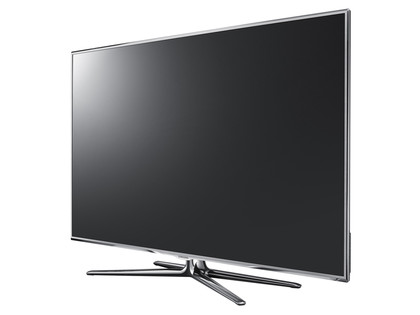Why you can trust TechRadar

Samsung's LED sets have proved their excellent picture pedigree over the last couple of years, and the UE46D8000 continues the company's fine run of form – although you'll need to carry out some serious tweaking in the setup menu before you start your movie viewing in earnest.
The Standard preset, which many users would head straight for, sees the contrast ramped right up to 100, giving the image a horribly garish and hyper-real look. Thankfully the UE46D8000 provides you with a detailed set of picture tweaks, ranging from the usual stuff like brightness and colour to more advanced tweaks like Black Tone, Colour Space and White Balance.
There are even built-in test patterns that allow you check if your calibration is hitting the spot. Next to these are the special picture modes like LED Motion Plus, Motion Lighting, noise filters… basically everything you need to get images looking exactly as you want them.
Get it right and the UE46D8000 will absolutely blow you away. With 2D discs like Transformers: Dark of the Moon, the busy 1080p pictures are rendered with the sort of forceful sharpness that draws you right into the picture. The intricate CG robots, all whirring cogs and gleaming chrome, look crisp and punchy, while humans are reproduced with equally impressive clarity, particularly the close-up shots of skin and hair with their life-like textures.
Detail doesn't greatly reduce in clarity when objects are moving either, which makes for steady, composed images no matter how busy the scene, although once or twice we noticed some brief twitching during the closing action scenes.
The movie also provides an ideal test of the set's motion processing. The constant barrage of fast, flying robots with moving parts, explosions and swarms of soldiers at the movie's overblown climax is enough to induce ADHD in any TV, but the UE46D8000 handles it all with admirable smoothness.
There are various tools in the setup menu to remove artefacts, Motion Plus having the most telling impact on picture quality (available in Clear, Standard, Smooth and Custom modes, the latter allows you adjust blur and judder reduction manually). But even without them the set manages to side-step judder and motion blur very well indeed. We recommend leaving the Smooth mode well alone, as it gives the image an unnatural feel, like it was shot with a home video camera.
Sign up for breaking news, reviews, opinion, top tech deals, and more.
What's also impressive is the amount of brightness this LED panel is able to kick out, even when you dial the factory backlight and brightness settings down to something approaching normality. That gives the image an instantly likeable, vibrant appearance.
But the best part is that it's backed up by terrific contrast and black levels, which keeps the image looking solid.Black parts of the picture are deep and realistic, not greyed over, while gloomy scenes look dark without losing that all-important shadow detail.
Checking for any backlight issues, we couldn't spot any pooling or unevenness – the black bars on 2.35:1 movies, for instance, are a textbook shade of black right the way across. The Micro Dimming really does result in an expansive contrast range, lending depth and punch to areas of the screen that need it but delivering eye-popping brightness in other parts of the same frame.
And the final piece of the 2D picture puzzle is colour, which thanks to the excellent brightness and contrast levels look sensational. Yes they dazzle when they need to – just check the Autobots' gleaming paintwork for proof – and they're never anything less than realistic, but it's the set's subtlety that really impresses, rendering gentle colour blends and tonal gradations beautifully. This lends the image an irresistible sense of depth and smoothness, as if you were watching the robo-carnage with your own eyes.
Turning to 3D, we find the UE46D8000 in fine fettle once again. That intense natural brightness pays dividends when viewing through the dimmed lenses of Samsung's 3D glasses (which, incidentally, seem lighter than its rivals' glasses). It uses the 2D qualities described above, namely superb brightness, deep black and vibrant-yet-nuanced colours, to deliver stereoscopic images that are out of this world – literally in the case of our 3D Avatar disc.
Pandora has rarely looked more spellbinding, with expertly layered objects and scenery, no obvious signs of motion blur and the sort of crisp, composed detail reproduction that'll leave you transfixed. However, there's no escaping slight traces of crosstalk in the image, which has blighted Samsung's 3D sets since day one, but it's not prevalent enough to take the shine off these otherwise superb 3D pictures.
And while we're talking 3D, the set's 2D-to-3D conversion is fairly good. It gives everything from the Transformers Blu-ray to Harry Hill's TV Burp a distinct sense of layering and depth without excessive artefacts, although it needs obvious cues to make it worthwhile – for much of the time the image just looks like a slightly warped version of 2D.
The UE46D8000 does a decent job with standard-definition material too. Pictures from the Freeview tuner are upscaled to the screen's resolution while maintaining excellent detail clarity. But the colour balance looks unnatural and slightly on the garish side, plus the set struggles to mask MPEG block noise, which makes it look a tad gauzy. There's also a touch of shimmering and mosquito noise with The Smurfs on DVD, but the strong blues are nicely handled and on the general image quality is solid.
